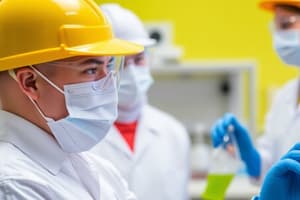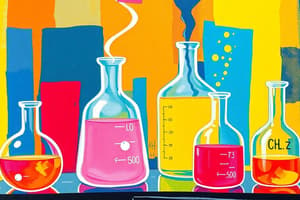Podcast
Questions and Answers
What types of products are considered toxic?
What types of products are considered toxic?
- Organic fertilizers
- Food preservatives
- Solvents for paints and wood treatment products (correct)
- Household cleaners only
What should you wear when handling corrosive substances?
What should you wear when handling corrosive substances?
- Safety gloves and goggles (correct)
- Only a mask
- No protection needed
- Only gloves
Which of the following is NOT an example of a harmful substance?
Which of the following is NOT an example of a harmful substance?
- Ammonia
- Oxygen (correct)
- Benzene
- Acids
What is a necessary action if there is an accidental projection of a harmful substance?
What is a necessary action if there is an accidental projection of a harmful substance?
What type of hazard is associated with gases that can cause explosions?
What type of hazard is associated with gases that can cause explosions?
What should be done with unused chemicals and their containers?
What should be done with unused chemicals and their containers?
When should protective eyewear be worn?
When should protective eyewear be worn?
What do labels on chemical products provide important information about?
What do labels on chemical products provide important information about?
What is the main advantage of using an Erlenmeyer flask over a beaker?
What is the main advantage of using an Erlenmeyer flask over a beaker?
Which of the following is NOT a valid use for a footed glass?
Which of the following is NOT a valid use for a footed glass?
What is the measuring precision of a graduated cylinder?
What is the measuring precision of a graduated cylinder?
Which piece of glassware is primarily used for precise volume dispensing in titrations?
Which piece of glassware is primarily used for precise volume dispensing in titrations?
What is a key characteristic of a volumetric pipette?
What is a key characteristic of a volumetric pipette?
What distinguishes a volumetric flask from other glassware?
What distinguishes a volumetric flask from other glassware?
What is a common use for a graduated pipette?
What is a common use for a graduated pipette?
Which of the following items is NOT suitable for heating?
Which of the following items is NOT suitable for heating?
What is the primary purpose of a separatory funnel?
What is the primary purpose of a separatory funnel?
Which piece of equipment is used to limit the risks of an exothermic reaction during reagent pouring?
Which piece of equipment is used to limit the risks of an exothermic reaction during reagent pouring?
Which statement is true about a beaker?
Which statement is true about a beaker?
What does a watch glass primarily store?
What does a watch glass primarily store?
What is the function of a delivery tube in laboratory settings?
What is the function of a delivery tube in laboratory settings?
What unique feature does the column head offer during distillation?
What unique feature does the column head offer during distillation?
In what manner does a propipette function?
In what manner does a propipette function?
Which of these containers cannot be heated?
Which of these containers cannot be heated?
What is the primary purpose of using a Büchner funnel in filtration?
What is the primary purpose of using a Büchner funnel in filtration?
What must be done before closing the water tap when disconnecting the vacuum flask from the water aspirator?
What must be done before closing the water tap when disconnecting the vacuum flask from the water aspirator?
How does the water aspirator reduce pressure in a container?
How does the water aspirator reduce pressure in a container?
What is the main function of the rotatory evaporator?
What is the main function of the rotatory evaporator?
Why is it important to remove water traces before using the rotary evaporator?
Why is it important to remove water traces before using the rotary evaporator?
Which drying agents are commonly used to eliminate traces of water from solutions?
Which drying agents are commonly used to eliminate traces of water from solutions?
What happens to the boiling point of a liquid when the pressure is lowered during evaporation?
What happens to the boiling point of a liquid when the pressure is lowered during evaporation?
What is the function of the cooling water in the rotary evaporator system?
What is the function of the cooling water in the rotary evaporator system?
What is the primary purpose of thin-layer chromatography (TLC)?
What is the primary purpose of thin-layer chromatography (TLC)?
Which of the following substances can be analyzed using TLC?
Which of the following substances can be analyzed using TLC?
What role does the stationary phase play in TLC?
What role does the stationary phase play in TLC?
What is a characteristic of the mobile phase in TLC?
What is a characteristic of the mobile phase in TLC?
Which of the following is NOT an application of TLC?
Which of the following is NOT an application of TLC?
Which component is responsible for maintaining a stable environment during TLC?
Which component is responsible for maintaining a stable environment during TLC?
How does TLC assist in pharmaceutical analysis?
How does TLC assist in pharmaceutical analysis?
What is the correct sequence of preparing for thin-layer chromatography?
What is the correct sequence of preparing for thin-layer chromatography?
Flashcards are hidden until you start studying
Study Notes
Chemical Safety Labels
- Toxic: Products that are toxic often cause serious health effects.
- Slightly Toxic: Products that are slightly toxic may cause moderate health effects.
- Nocif: Products labeled "Nocif" can cause irritation to skin and mucous membranes.
- Corrosif: Corrosive products can cause severe burns or damage.
- Danger for the Environment: These products are harmful to wildlife, aquatic animals, or the ozone layer.
- Danger for Health: Products that pose a health hazard can cause damage to living tissue.
- Compressed Gas: These products pose a risk of explosions due to the presence of flammable gases.
Lab Equipment
- Erlenmeyer flask: Useful for storing volatile chemicals, performing reactions with volatile compounds, or for volumetric titrations. However, the graduations are only approximate and should not be used for precise volume measurements.
- Beaker: Can be used for a variety of tasks, but is not ideal for volatile liquids.
- Graduated Cylinder: Used to measure liquid volumes with moderate precision (around 0.5 mL). Choose a cylinder as close to the desired volume as possible.
- Burette: Used to accurately dispense and measure cumulative volumes of solutions. Particularly useful in volumetric titrations.
- Volumetric Pipette: Utilizes one or two lines to accurately measure small liquid volumes (typically 2.0 mL, 5.0 mL, 10.0 mL, and 20.0 mL). It is used for solution preparation.
- Graduated Pipette: Used to measure small liquid volumes with moderate precision. Used for solution preparation.
- Volumetric Flask: Utilizes a single line to accurately measure a specific volume. Employs a stopper for sealing and can be heated if made of Pyrex.
- Funnel: Facilitates pouring liquids into narrow-necked flasks to prevent spills. Additionally, used for filtration setups.
- Dropping Funnel: Used for controlled, dropwise addition of reagents, particularly in exothermic reactions.
- Crystallizer: A thick glass vessel for storing large quantities of water, often serving as a water bath for gas collection by displacement. Not suitable for heating.
- Watch Glass: Used for storing small amounts of solid materials. Suitable for weighing small quantities. Not suitable for heating.
- Delivery Tube: A curved glass tube that fits into test tubes (via a stopper) to collect or direct gases.
- Column Head: Utilized in distillation or hydrodistillation setups. Connects vertically to a flask or Vigreux column and laterally to a straight condenser.
- Propipette: Adapted to volumetric or graduated pipettes to create a vacuum. Used for drawing liquid into the pipette.
Techniques and Processes
- Filtration: Used to separate solid particles from a liquid.
- Vacuum Filtration (Büchner Funnel): A fast technique for separating a solid from a liquid.
- Evaporation: Used for separating liquids based on their volatility.
- Rotary Evaporator: Utilized for quickly removing a volatile solvent by evaporation.
- Thin Layer Chromatography (TLC): A technique for separating components of a mixture based on their different affinities for the stationary and mobile phases.
Applications of Thin Layer Chromatography
- Qualitative analysis: Can be used to identify and analyze substances in a variety of fields.
- Biochemical analysis: Used to separate metabolites in urine or blood.
- Natural product analysis: Helpful in identifying natural products like essential oils, glycosides, and alkaloids.
- Pharmaceutical analysis: Useful in separating and identifying components of multi-component pharmaceutical formulations.
- Food analysis: Used to separate and identify food additives, such as colorants, sweeteners, and preservatives.
- Studying reaction completion: Helps to determine if a chemical reaction has reached completion.
Components of Thin Layer Chromatography
- TLC Plates: Ready-to-use plates containing a thin layer of stationary phase.
- Chromatography Chamber: Maintain a stable environment for developing TLC plates.
- Mobile Phase: A mixture of solvents or a single solvent that moves through the stationary phase.
Studying That Suits You
Use AI to generate personalized quizzes and flashcards to suit your learning preferences.




